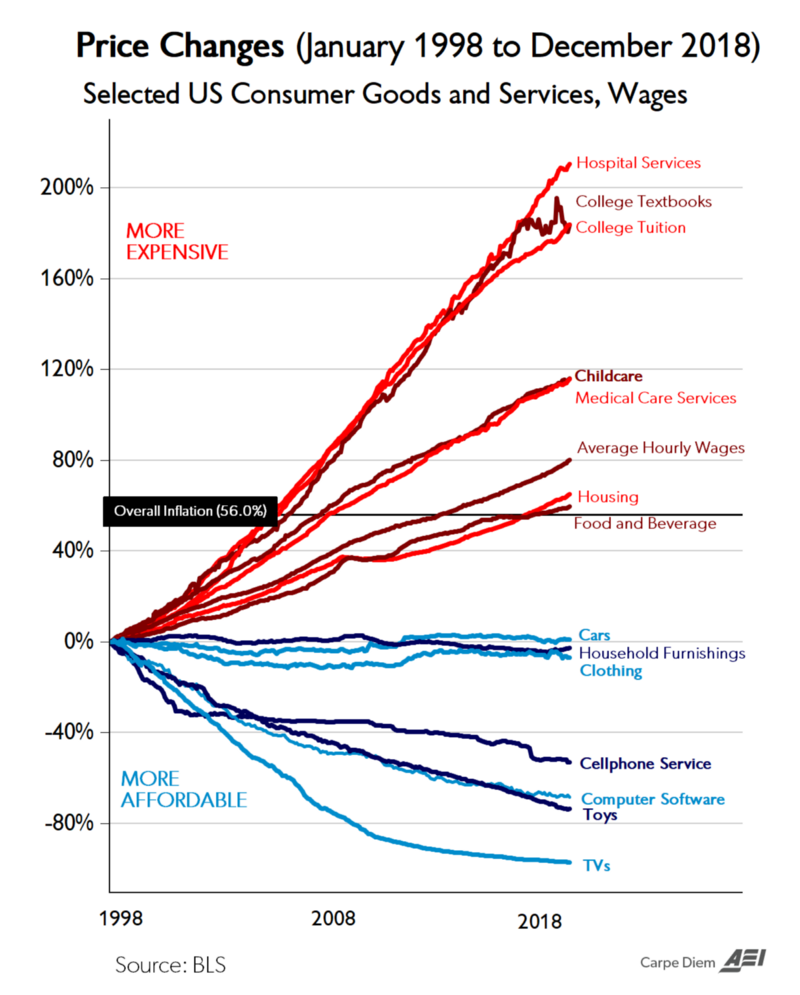Our investment in Kaia Health: how software can tackle chronic pain
Working in technology, you see plenty of graphs. But one graph bothers me more above all of them:

While new markets, practices and technologies have seen the cost of many goods fall over the last few decades, healthcare has remained stubbornly expensive. And even more worryingly, the length and quality of life we get for these high costs are falling. The healthcare industry is suffering from its own ailment, Baumol’s cost disease.
Given the radical impact software has had on other industries, it’s frustrating that change has been so incremental in health. And this is not for lack of capital. The first wave of investment in health tech (by which I mean software rather than infrastructure or pharmaceuticals ) predominantly went into companies that bring processes and data that was otherwise captured on paper, slides or other silos into more accessible digital formats.
As a result, there are now many ways you can now talk to a clinician through an app on your phone, or access your health records digitally.
While that’s an improvement indeed, the biggest challenge in healthcare today is not the lack of access to clinicians, but their availability. The demands on modern carers far outstrip the resources we give them. From overworked Doctors to underpaid and poorly treated carers, efficiency gains in health care won’t happen until technology is used to relieve demand on these professionals, and provide them with the tools to make their work more manageable and impactful.
In short, it’s not demand for that we need to solve for, but the supply of healthcare.
So at Balderton, we have been asking ourselves the question, how can software be used to provide better healthcare to more people for less money?
Our health tech investment thesis:
Some of our recent investments in health reflect our focus on the supply side. Sophia Genetics applies machine learning techniques to new data sets, building tools for its community of bioinformaticians that gives a single hospital the equivalent resources of a $100M+ laboratory through software. HealX uses cutting edge research with its community of researchers and patients with rare diseases to bring the sophistication of an entire pharmaceutical research department to some of the world’s most difficult pharmaceutical problems.
We believe the next wave of health tech will be built this way, through integrations with existing clinical practices, but extending those systems well beyond the hospital walls, utilising the power and scale of new technologies and expert communities to improve and democratise both diagnosis and treatment.
From diagnosis to treatment, our investment in Kaia Health:
So with this in mind, we were excited to get the chance to invest in Kaia Health, which uses your smartphone and a combination of content and computer vision to provide clinical-level physiotherapy to the world for a fraction of the cost of surgery, opiates or regular physicians.
Kaia has started with a focus on tackling back pain, an issue which the founder knows personally. Back pain is amongst the most prevalent health issues in the world. In America alone it is estimated to affect 100 million people a year, is closely linked to issues of employment, self-esteem and depression and is the number one reason that people are prescribed painkillers. The growing use of opioid-based painkillers, in particular, Oxycotin, has been described as now at epidemic levels in the US.
In the UK, 30% of all GP appointments are MSK-related, costing the NHS at least £5B a year. So reducing the need to prescribe painkillers or reducing the number of MSK interventions isn’t just a hugely beneficial outcome for patients, it will release huge resources for health care institutions to use elsewhere.
The health industry is well aware of this. Kaia Health is already reimbursable for tens of millions of Germans through partnerships with the leading health insurers in the country, and it is soon to announce a range of partnerships with corporates who see chronic back pain as a huge issue for their staff.
Building platforms not products:
The platform Kaia Health is building has the potential to extend well beyond back pain. By combining clinical levels of research with longitudinal tracking and computer vision expertise, Kaia is becoming a platform for any intervention where pain can be relieved through regular clinical observation and guidance. They have already released research showing the impact of their system on sufferers of COPD, a family of lung diseases, and have started testing tools for patients with other diseases.
Kaia Health is also part of a small but growing cadre of companies defying norms in health by crossing the chasm between consumer and clinical healthcare, and focussing on people outside of the ‘beach body ready’ demographic that has been the focus of a lot of VC investment.
Rather than just giving patients another way to connect to a carer, Kaia Health has utilised the most powerful and prevalent tools we have to provide clinically effective health treatments, at a fraction of the cost, freeing up physiotherapists time for more meaningful interactions. It’s an exciting antidote to the Baumol cost disease, and one we hope will change many people’s lives.
